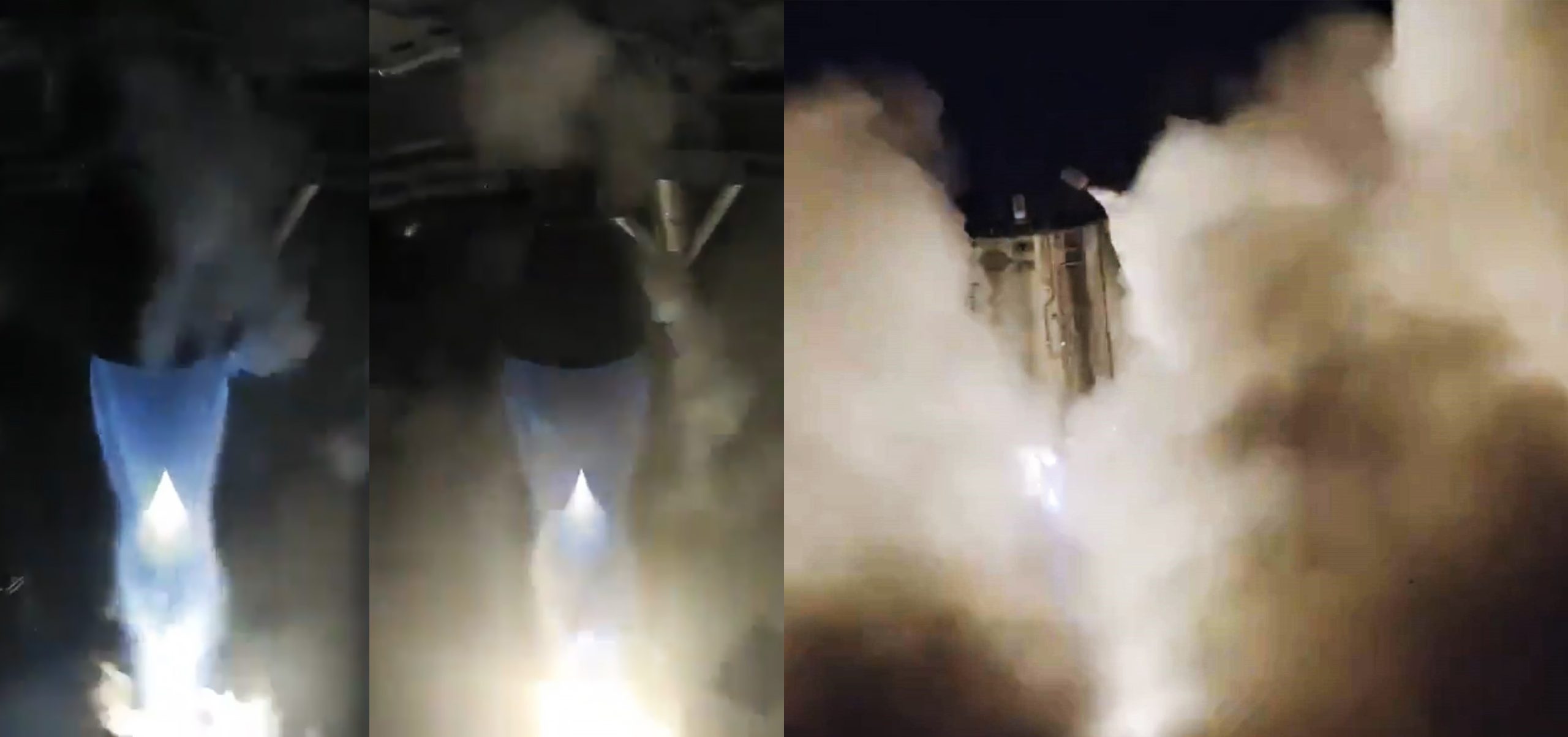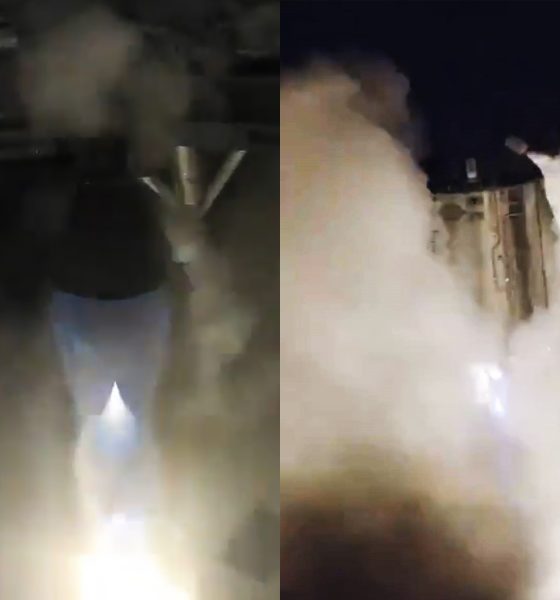

News
SpaceX CEO Elon Musk posts uncut Raptor, drone videos of Starhopper’s flight test debut
Some two hours after Starhopper’s inaugural untethered flight, SpaceX CEO Elon Musk took to Twitter to post an uncut video showing the ungainly rocket’s launch and landing from the perspective of both a drone and Starhopper’s lone Raptor engine.
As noted by commenters, Starhopper’s first flight also marks perhaps an even more fascinating milestone: it’s technically the first launch ever of a full-flow staged-combustion (FFSC) rocket engine. Whether or not the development hell Raptor required is or was worth it to SpaceX, the company has become the first and only entity on Earth to develop and fly a FFSC engine, beating out the national space agencies of both the United States and Soviet Union, both of which built – but never flew – prototypes.
Instead of inexplicably shelving a mature prototype development and test program, SpaceX iterated through several subscale Raptor prototypes, test-fired the engines for more than 1200 seconds total, used that data to design and build full-scale Raptors, and finally sped into a hardware-rich test campaign with six (soon to be seven) new engines. After SpaceX settled on a full-flow staged-combustion cycle and methane/oxygen (methalox) propellant, Raptor conducted its first full-scale tests all the way back in 2014, performing preburner flow and ignition tests at NASA’s Stennis Space Center.
Two years and many additional subcomponent tests later, SpaceX successfully performed the inaugural static fire test of its first completed subscale Raptor, a huge milestone for any rocket engine. In the 12 months following its first static fire (September 2016), SpaceX performed dozens of static fire tests with several subscale engines, putting the new propulsion system through >1200 seconds of combined testing.
A year after that, SpaceX was still testing subscale engines but the first full-scale Raptor engine was just a few months away from completing assembly in Hawthorne and heading to McGregor to kick off full-scale static fire testing. Indeed, four months after CEO Elon Musk’s September 2018 update, Raptor serial number 01 (SN01) shipped to Texas in late January and successfully ignited for the first time on February 3rd. SpaceX’s finalized full-scale Raptor engine is designed to produce more than 2000 kN (450,000 lbf, 200 tons) of thrust at full-throttle.
Since that inaugural ignition, SpaceX’s propulsion team – perhaps to their detriment, under orders from Musk – pushed SN01 and several of its successors to their limits as quickly as possible, resulting in severe, irreparable damage in several cases. On the other hand, the no-holds-barred, ‘hardware-rich’ (i.e. destructive) test program has allowed SpaceX to relatively quickly solve several major bugs that prevented the engine from passing longer test fires.
Raptor SN05 was originally expected to support Starhopper’s first flight(s) but had to be passed up after suffering damage in one of its final June 2019 acceptance tests. Raptor SN06 became the first engine – likely thanks to tweaks afforded by data gathered from its failed brethren – to pass all of those acceptance tests, leading to its eventual installation on Starhopper in early July.
Raptor’s impressive development culminated on July 25th with the engine’s first untethered flight while attached to Starhopper, a 9m-diameter (30 ft) low-fidelity prototype that is more or less a mobile test stand for the next-generation SpaceX engine. Raptor is now the only FFSC engine in history that has powered a flight-capable vehicle’s launch and landing, even if said flight featured an apogee of just 20-30 meters (65-100 ft).
“In full-flow staged combustion (FFSC), even more complexity is added as all propellant that touches the engine must necessarily end up traveling through the main combustion chamber to eke every last ounce of thrust out of the finite propellant a rocket lifts off with. As such, FFSC engines can be about as efficient as the laws of physics allow any given chemical rocket engine to be, at the cost of exceptional complexity and brutally difficult development.“
SpaceX delays Starhopper’s first flight a few days despite Raptor preburner test success
For more on what exactly makes full-flow staged-combustion engines uniquely capable and challenging to develop, the subject has been covered at length in past Teslarati articles.
According to Musk, the next major challenge facing Starhopper and (presumably) Raptor SN06 is far more ambitious 200-meter (650 ft) hop and flight test that could happen as soon as the first half of August.
Check out Teslarati’s Marketplace! We offer Tesla accessories, including for the Tesla Cybertruck and Tesla Model 3.

Elon Musk
Starlink passes 9 million active customers just weeks after hitting 8 million
The milestone highlights the accelerating growth of Starlink, which has now been adding over 20,000 new users per day.

SpaceX’s Starlink satellite internet service has continued its rapid global expansion, surpassing 9 million active customers just weeks after crossing the 8 million mark.
The milestone highlights the accelerating growth of Starlink, which has now been adding over 20,000 new users per day.
9 million customers
In a post on X, SpaceX stated that Starlink now serves over 9 million active users across 155 countries, territories, and markets. The company reached 8 million customers in early November, meaning it added roughly 1 million subscribers in under seven weeks, or about 21,275 new users on average per day.
“Starlink is connecting more than 9M active customers with high-speed internet across 155 countries, territories, and many other markets,” Starlink wrote in a post on its official X account. SpaceX President Gwynne Shotwell also celebrated the milestone on X. “A huge thank you to all of our customers and congrats to the Starlink team for such an incredible product,” she wrote.
That growth rate reflects both rising demand for broadband in underserved regions and Starlink’s expanding satellite constellation, which now includes more than 9,000 low-Earth-orbit satellites designed to deliver high-speed, low-latency internet worldwide.
Starlink’s momentum
Starlink’s momentum has been building up. SpaceX reported 4.6 million Starlink customers in December 2024, followed by 7 million by August 2025, and 8 million customers in November. Independent data also suggests Starlink usage is rising sharply, with Cloudflare reporting that global web traffic from Starlink users more than doubled in 2025, as noted in an Insider report.
Starlink’s momentum is increasingly tied to SpaceX’s broader financial outlook. Elon Musk has said the satellite network is “by far” the company’s largest revenue driver, and reports suggest SpaceX may be positioning itself for an initial public offering as soon as next year, with valuations estimated as high as $1.5 trillion. Musk has also suggested in the past that Starlink could have its own IPO in the future.
News
NVIDIA Director of Robotics: Tesla FSD v14 is the first AI to pass the “Physical Turing Test”
After testing FSD v14, Fan stated that his experience with FSD felt magical at first, but it soon started to feel like a routine.

NVIDIA Director of Robotics Jim Fan has praised Tesla’s Full Self-Driving (Supervised) v14 as the first AI to pass what he described as a “Physical Turing Test.”
After testing FSD v14, Fan stated that his experience with FSD felt magical at first, but it soon started to feel like a routine. And just like smartphones today, removing it now would “actively hurt.”
Jim Fan’s hands-on FSD v14 impressions
Fan, a leading researcher in embodied AI who is currently solving Physical AI at NVIDIA and spearheading the company’s Project GR00T initiative, noted that he actually was late to the Tesla game. He was, however, one of the first to try out FSD v14.
“I was very late to own a Tesla but among the earliest to try out FSD v14. It’s perhaps the first time I experience an AI that passes the Physical Turing Test: after a long day at work, you press a button, lay back, and couldn’t tell if a neural net or a human drove you home,” Fan wrote in a post on X.
Fan added: “Despite knowing exactly how robot learning works, I still find it magical watching the steering wheel turn by itself. First it feels surreal, next it becomes routine. Then, like the smartphone, taking it away actively hurts. This is how humanity gets rewired and glued to god-like technologies.”
The Physical Turing Test
The original Turing Test was conceived by Alan Turing in 1950, and it was aimed at determining if a machine could exhibit behavior that is equivalent to or indistinguishable from a human. By focusing on text-based conversations, the original Turing Test set a high bar for natural language processing and machine learning.
This test has been passed by today’s large language models. However, the capability to converse in a humanlike manner is a completely different challenge from performing real-world problem-solving or physical interactions. Thus, Fan introduced the Physical Turing Test, which challenges AI systems to demonstrate intelligence through physical actions.
Based on Fan’s comments, Tesla has demonstrated these intelligent physical actions with FSD v14. Elon Musk agreed with the NVIDIA executive, stating in a post on X that with FSD v14, “you can sense the sentience maturing.” Musk also praised Tesla AI, calling it the best “real-world AI” today.
News
Tesla AI team burns the Christmas midnight oil by releasing FSD v14.2.2.1
The update was released just a day after FSD v14.2.2 started rolling out to customers.

Tesla is burning the midnight oil this Christmas, with the Tesla AI team quietly rolling out Full Self-Driving (Supervised) v14.2.2.1 just a day after FSD v14.2.2 started rolling out to customers.
Tesla owner shares insights on FSD v14.2.2.1
Longtime Tesla owner and FSD tester @BLKMDL3 shared some insights following several drives with FSD v14.2.2.1 in rainy Los Angeles conditions with standing water and faded lane lines. He reported zero steering hesitation or stutter, confident lane changes, and maneuvers executed with precision that evoked the performance of Tesla’s driverless Robotaxis in Austin.
Parking performance impressed, with most spots nailed perfectly, including tight, sharp turns, in single attempts without shaky steering. One minor offset happened only due to another vehicle that was parked over the line, which FSD accommodated by a few extra inches. In rain that typically erases road markings, FSD visualized lanes and turn lines better than humans, positioning itself flawlessly when entering new streets as well.
“Took it up a dark, wet, and twisty canyon road up and down the hill tonight and it went very well as to be expected. Stayed centered in the lane, kept speed well and gives a confidence inspiring steering feel where it handles these curvy roads better than the majority of human drivers,” the Tesla owner wrote in a post on X.
Tesla’s FSD v14.2.2 update
Just a day before FSD v14.2.2.1’s release, Tesla rolled out FSD v14.2.2, which was focused on smoother real-world performance, better obstacle awareness, and precise end-of-trip routing. According to the update’s release notes, FSD v14.2.2 upgrades the vision encoder neural network with higher resolution features, enhancing detection of emergency vehicles, road obstacles, and human gestures.
New Arrival Options also allowed users to select preferred drop-off styles, such as Parking Lot, Street, Driveway, Parking Garage, or Curbside, with the navigation pin automatically adjusting to the ideal spot. Other refinements include pulling over for emergency vehicles, real-time vision-based detours for blocked roads, improved gate and debris handling, and Speed Profiles for customized driving styles.








